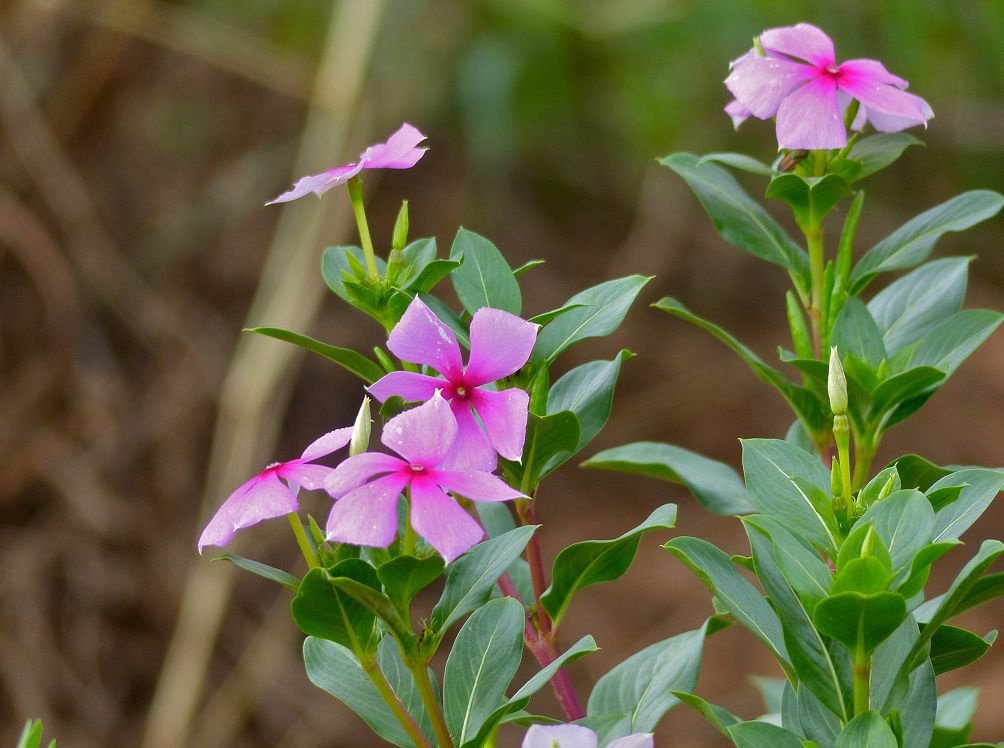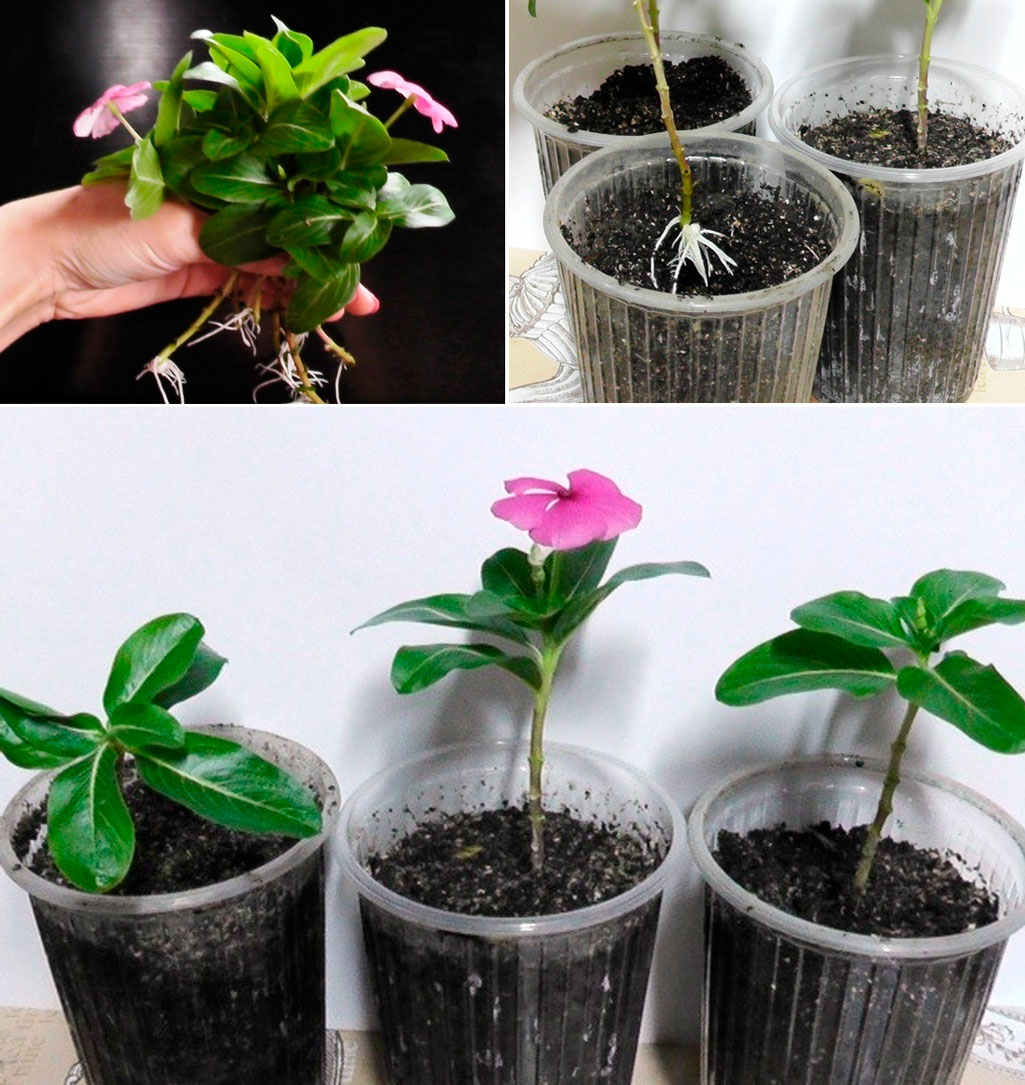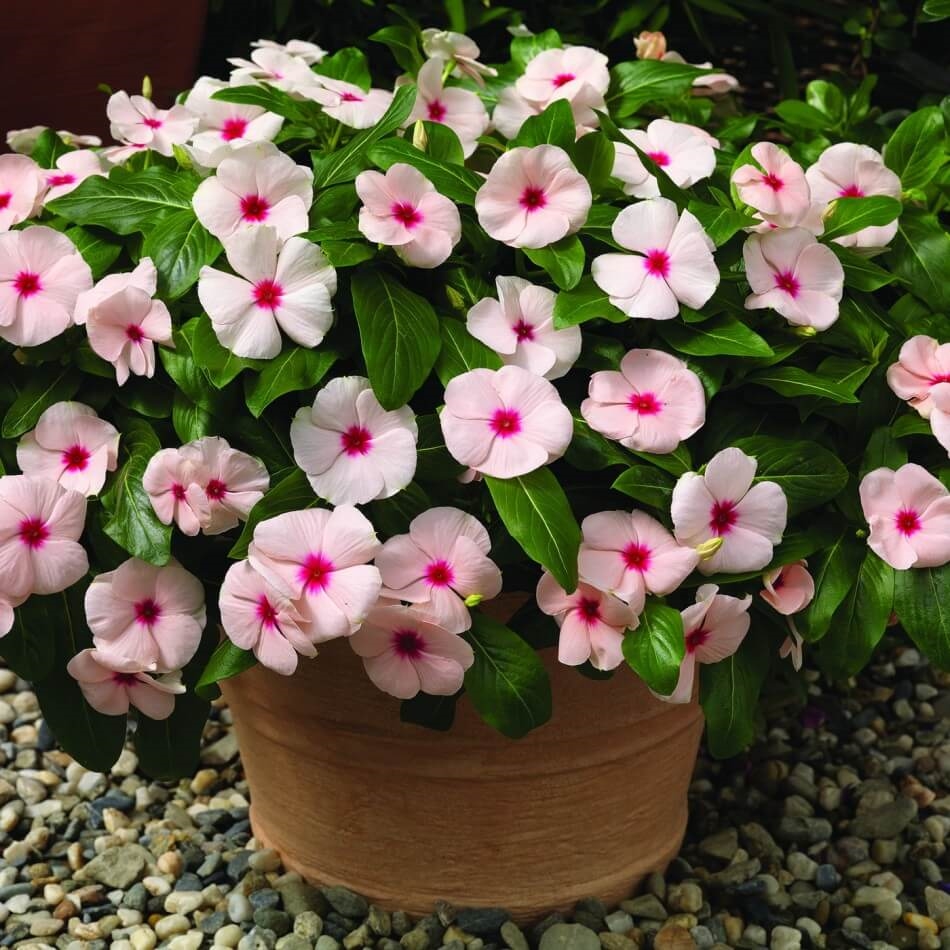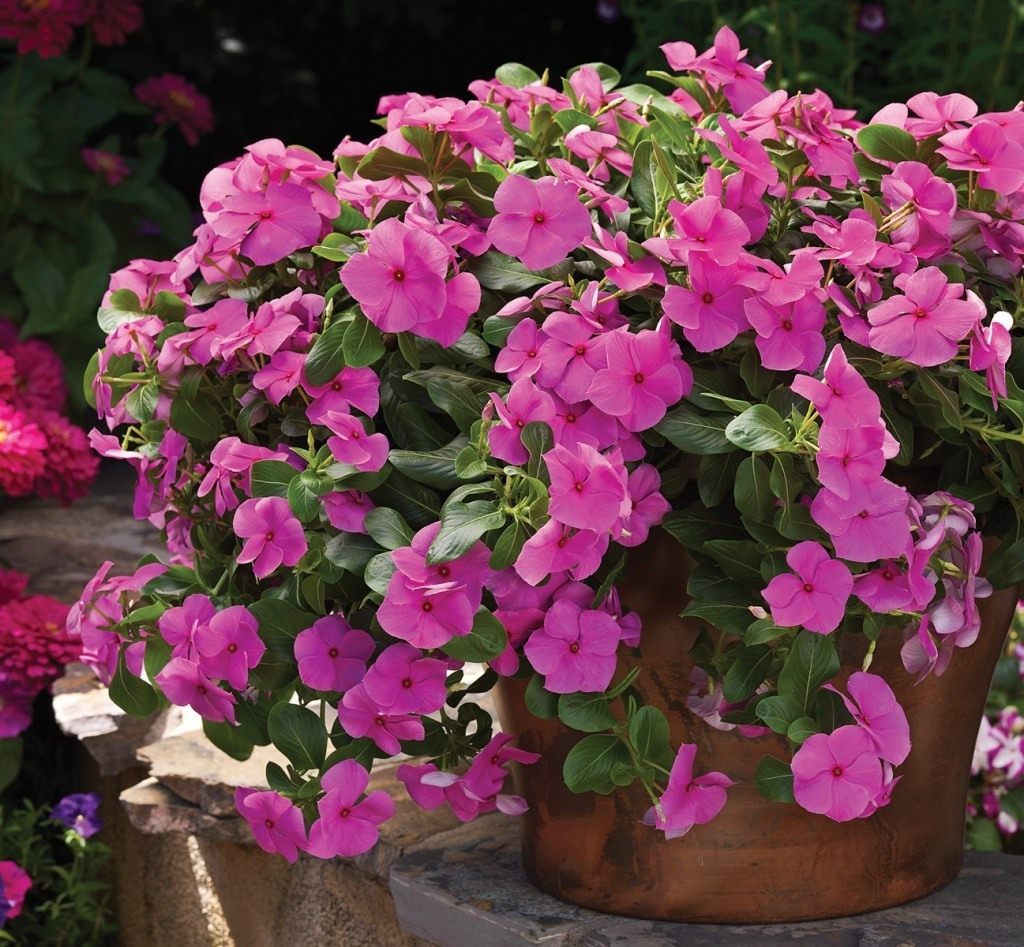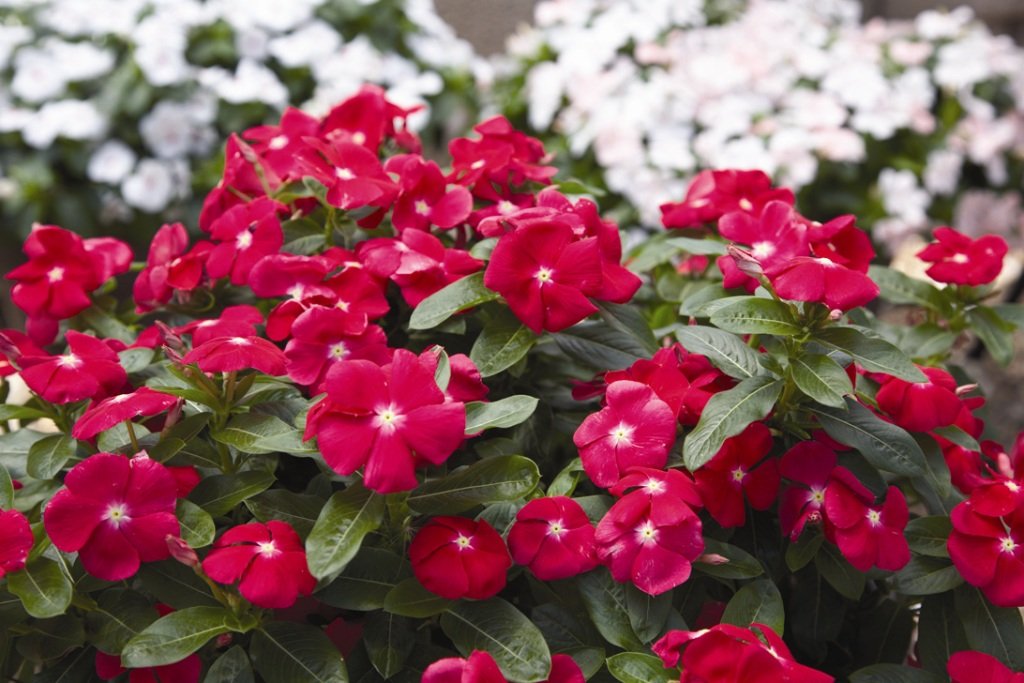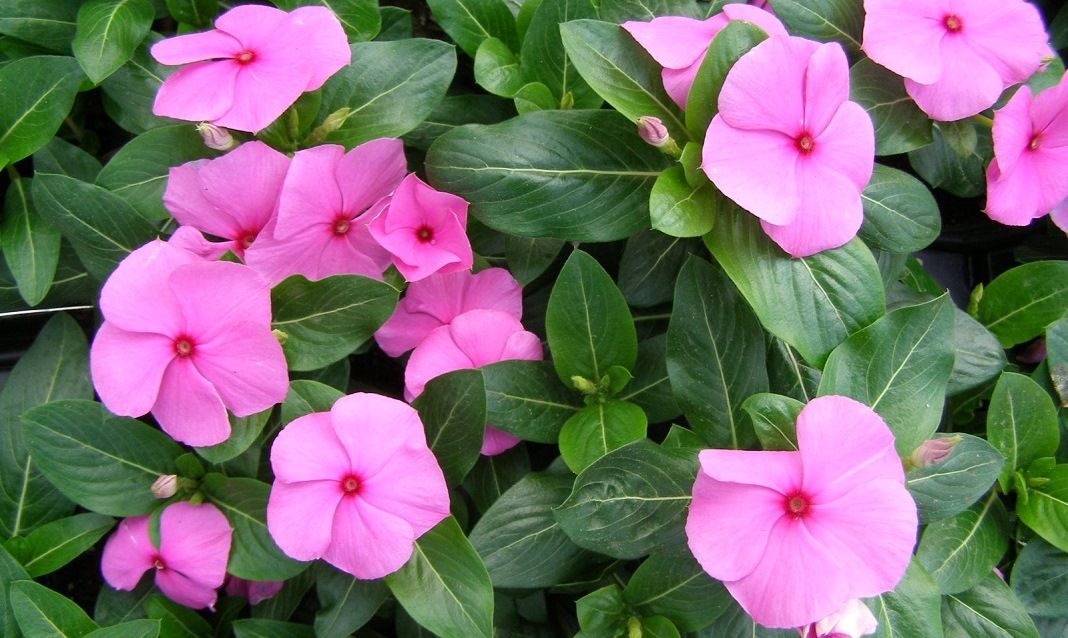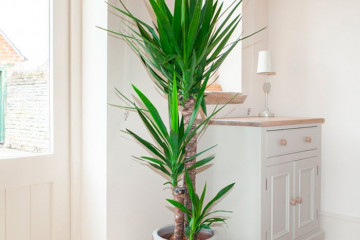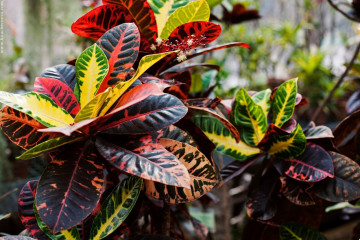Catharanthus flower: home care and breeding methods
Content:
Katarantus is an ornamental and very unpretentious herb from the Kutrov family, growing both at home and in the garden. The flower prefers a tropical climate, common in the light forests of Madagascar. In Russia, the most famous names for the catharanthus are "periwinkle", "Madagascar wine" and "lonera". In addition, the plant is sometimes called "old maid" or "cayenne jasmine". It is very difficult for the flower to tolerate low temperatures, therefore, in a garden, it is grown as an annual. In southern latitudes, its life span is longer - up to several years.
Main types
Almost all types of catharanthus have similar features and properties, namely:
- strong trunk and increased branching. Greenish shoots sometimes have a pink tint;
- green shimmering foliage with beige veins, short stalks;
- the average height of the bush is 1 m;
- The 5-petal flower has a white or burgundy color.
Below are the main types of culture.
Periwinkle catharanthus
Periwinkle catharanthus is a deciduous shrub, whose height is on average up to 1 m. The flower is classified as a number of small plants, but under optimal conditions it can grow up to one and a half meters. It is usually grown from seeds. When planting a catharanthus in the last days of winter, the plant will bloom from late spring to autumn.
Catharanthus pink
Catharanthus pink is intended for growing at home. In the tropics it grows more actively (there its height reaches 1.5 m), in Russian conditions the height does not exceed 1 m. 7-centimeter lanceolate leaves in the center have a characteristic beige vein. The edges of the foliage are quite even, the surface is glossy. The color of the flowers varies depending on the variety. Long-term flowering, largely depends on the conditions of detention, weather and climate. At low temperatures, flowering lasts about six months. In warm climates, the catharanthus flower can bloom throughout the year.
Katarantus bush
Katarantus bush — a compact plant with large dark green leaves and bright saturated 5 cm flowers. This type is suitable for growing indoors, on a balcony, loggia, or can be used to decorate flower beds. This type of transport is therefore excellent for sale.
In addition to the above types of catharanthus, the following are also distinguished:
- ampelous - Cascade, Mediterranean;
- Aristocrat;
- Pacific;
- Pacific burgundy;
- Pacific epricot;
- Pacific white;
- First kiss.
Katarantus: planting and care at home
How to grow and care for a catharanthus at home? To grow a healthy and beautiful catharanthus bush, you must follow some rules and recommendations for caring for the plant.
Humidity
Catharanthus is a moisture-loving plant. During the period of abundant flowering, it needs a fairly high humidity, and this applies not only to the air, but also to the soil. If the humidity drops below the 60% mark, you need to spray the ambient air and lightly the plant itself. It is allowed to spray the foliage, but the flowers are not recommended. To increase the humidity in the room, place a container filled with water close to the plant. It is also recommended to pour wet expanded clay or wet pebbles into the pallet and put a flower pot in it.
Priming
Catharanthus grows well in loose, light and fertile soil. As it, you can use purchased land intended for flowering indoor plants, for example, for geraniums. When self-cooking, the composition must include leaf and sod land, a small amount of peat and coarse river sand.
Watering
Before watering, you need to take care of the drainage layer or manually drain the excess water after each procedure. In rainy weather, the catharanthus growing in the open air can slow down its development due to an excess of moisture in the soil. And if the soil turns out to be too dense, then with regular flooding, the plant may even die.
It is necessary to ensure that the soil does not dry out, since with a lack of moisture, the condition of the flower can deteriorate significantly. In some varieties, in this case, the leaves may curl - this is the first symptom of moisture deficiency.
Lighting
For the catharanthus, well-lit places are most preferable. It is important that the direct rays of the sun hit the plant in a minimum amount. The flower pot can be placed on the windowsill on the west or east side. In the summer, the catharanthus will not be disturbed by sunbathing. To do this, it is left in the fresh air, protecting it from possible precipitation.
Temperature
The ideal temperature for catharanthus in room conditions is 20-25 ° C. These indicators are relevant for a flower from early spring to late summer. When winter comes, the plant should be placed in a cooler place (around 15 ° C). During this period, it is not recommended to put the pot on the windowsill, especially if there are heating devices nearby. The minimum content temperature is 10 ° C.
The flower will feel especially comfortable outdoors. With the onset of spring, when the air warms up to 18 ° C, the container with the catharanthus can be placed on the balcony or veranda, under a canopy that can protect the plant from precipitation, gusts of wind and direct sunlight. At the first drop in temperature (August-September), the catharanthus should be brought into the house.
Top dressing
The indoor flower catharanthus responds very well to top dressing, so fertilizers must be applied to the soil with enviable regularity. It needs nutrients, so universal mixtures for flowering plants can be used as fertilizers. Top dressing should be done 2 times a month throughout the season. Nutrient fertilizers are applied at the root. The plant loves a mixture of ash (100 g) diluted in water (1 bucket).
Features of plant transplant
A flower transplant should be done every year. A day before transplanting, the flower should not be moistened, but it is better to give it time to form an earthen coma around the rhizome.
Choosing a pot and planter
Catharanthus is a fast growing flower. In conditions of a small capacity, the root system is not easy to develop, since it quickly fills the entire area and clogs the drainage holes.It is necessary to take care of the place for the growth of the rhizome. The health state of the catharanthus will depend on the correct choice of the pot. The capacity should not be small, because the catharanthus develops very quickly, it needs a lot of free space.
The best option is a clay or plastic pot. With each new transplant, the size of the container should increase in diameter by 3 cm relative to the size of the previous pot. The bottom of the container must have drainage holes, if they are absent, then they must be made with your own hands.
To transplant a flower into a new pot, you need to do the following:
- Inspect the plant, if necessary, make pruning.
- Pick up a larger pot, make drainage holes in it.
- It is necessary to transplant by the method of transshipment of the plant along with the soil. This should be done carefully, avoiding trauma to the root system.
- Add the same potting mix to the new container as in the previous season. With a strong difference in the soil, the flower will not bloom.
- To make it easier to remove the catharanthus from the pot, you can add a little water to the surface of the soil. Plastic containers are sometimes cut or even broken. In this case, it is important not to harm the delicate root system of the plant.
Pruning
Cutting the catharanthus should be done in the spring. The main stems are trimmed by a third. This procedure will allow the flower to significantly rejuvenate, and will also give the bush neatness, and subsequently abundant flowering. Broken and dry branches should also be removed. The remaining cuttings can be used to propagate the crop.
Some growers are wondering whether it is necessary to pinch the catharanthus? To form a compact, beautiful crown, the ends of the shoots should be pinched. This will slow down their growth upward, while actively developing lateral branches will make the crown thicker and more decorative.
During the period of active flowering, the plant needs constant care. Withered flowers and faded foliage must be removed regularly as they can spoil the appearance of the catharanthus.
Reproduction methods
Catharanthus can be propagated in three ways:
- cuttings;
- seeds;
- division.
Katarantus: growing from cuttings
Before starting the procedure, you need to prepare:
- cut green shoots from the bushes (up to 15 cm);
- remove the lower foliage, treat the sections with a biostimulant root.
Rooting procedure:
- Place the stalk in a moist substrate, which includes peat and perlite in equal proportions. Cover the container with a lid, making a mini greenhouse.
- During the month, regularly ventilate, spray and water the cuttings.
- Then carefully transplant the cuttings into the ground. The potting mix should be light and nutritious.
Seeds
Seed planting is carried out in the last days of winter or in spring. The procedure is as follows:
- Deepen the seeds 2 cm into the soil. Water the soil abundantly.
- Cover the planting with plastic wrap. The seeds need darkness to germinate. The optimum temperature is 22-24 ° C.
- Seedlings will appear after a week. The seedlings should be placed in a bright place, the temperature should be slightly reduced.
- After 15 days, feed (the concentration of phosphorus should be minimal).
- After the formation of four true leaves, make a pick.
By dividing the bush
The procedure is as follows:
- Remove the flower from the container. This must be done carefully so as not to harm either the leaves or the trunk.
- Divide the plant into parts with your hands.
- Make a drainage layer at the bottom of the pot, pour the nutrient mixture (a little) on top of it.
- Place the flower in the center of the pot and spread the rhizome. The roots should be evenly spread over the entire area.
- Holding the bush in one hand, sprinkle the soil around the edges.
- Pull the plant up slightly so that the roots can straighten out.
- Pour the earth into the container to the very top. Compact and water the soil.
- At first, the plant should be protected from direct sunlight.
Possible growing problems
Catharanthus, like any other house plant, must be carefully monitored so that, in the event of the first symptoms of an ailment, take action and correct care errors. The most common problems with growing catharanthus are yellowing and falling foliage.
Leaves turn yellow
To begin with, it is worth figuring out why the leaves of the catharanthus turn yellow. There may be several reasons. If, in addition to the yellow tint on the leaves, the plant has lost its shape and began to wither, then the reason is most likely in the prolonged exposure of the flower to the sun. In this case, it will be enough to rearrange it deeper into the room.
If the flower changes color to yellowish from the tips of the leaves, the air humidity is probably too low for the flower. If this is the case, then a container of water can be placed next to the plant, or you can spray it regularly. In some cases, yellowing of the foliage can be triggered by the small size of the container in which it is located.
Leaves fall
When foliage falls, the first thing you should pay attention to is the drying out of the soil. If some of the leaves are twisted, and some have already fallen, then the reason is insufficient watering. Drying and falling of the leaves of the lower tier, as well as baldness of the flower, suggests that, most likely, the period of the flower's life is coming to an end. At home, this most often occurs in the third year of cultivation.
Catharanthus is a compact, small bush that pleases the eye with the colorful appearance of its flowers. Knowing the simple rules for caring for a catharanthus at home, even an inexperienced florist can decorate the interior of his home with this beautiful plant.
